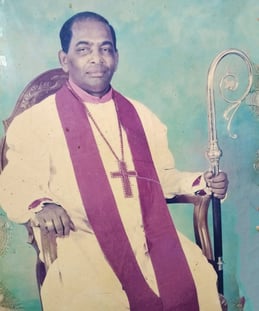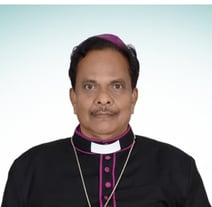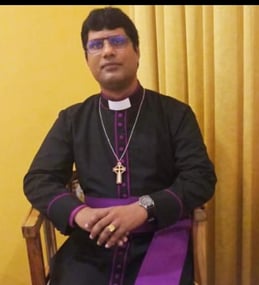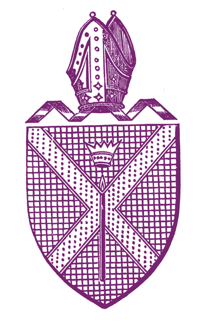Early in 1876, the Society began negotiations with the Secretary of State for India so that a new see might be formed under the Jerusalem Bishopric Act 1 for the Church of England in the Native States of Travancore and Cochin. And towards the end of the year a public announcement was made that the Rev. J. M. Speechly would be the first Bishop of the New Diocese. It was also made clear that "the appointment of an experienced European Missionary as a Bishop was a preparatory step to the ultimate appointment of native Bishops". 2 Rev. J. M. Speechly (1879-1888) was consecrated as the first Bishop for the newly formed Anglican Diocese of Travancore and Cochin, on St. James Day, the 25 July 1879, in St. Paul's Cathedral, London, and he arrived at Kottayam on January 27, 1880.
The main intention of the Society to form a Diocese was, "to build up well-trained native congregations under native pastors... to resign all pastoral work into their hands" and for the missionary gradually, "to relax his superintendence over the pastors themselves, till it insensibly ceases." To this end there began a steady increase in the number of the local ministers and the condition of the Native Church began to be improved.
From July 18 80, a Diocesan Magazine in English was published known as 'The Diocesan Gazette' and later changed its name as 'The Diocesan Record'. The editor wrote, "Our readers are lay and clerical, native and European, learned and liberal Hindus, the Christians of the S.P.G. (Society for Promoting Gospel), L.M.S. (London Missionary Society), and C.M.S. Missions. We have subscribers in the three presidencies." 4 During the episcopate of Bishop Speechly there were four Mission districts - Kottayam, Mavelikara, Thiruvalla and Mundakayam, of which Melukavu Mission was a part. The Mundakayam Mission District was not yet incorporated with the provincial council.
It was another step forward in the Diocesan life when in 1885 a Malayalee, the Rev. K. Koshi, was appointed Archdeacon of Kottayam. The Rev. J. Caley was the Archdeacon of Mavelikara.
In 1885, Rev. K. Koshy became the first Indian to be raised to the rank of an archdeacon.Adn. Koshy was the editor of Njananikshepam (published since 1840), the first Malayalam periodical.[
Our History




In 2010, the Diocese of Travancore and Cochin was restored into the Church of India CIPBC. Lord Bishop Noel Hembrom succeeded Late.Rt.Rev.K M Chacko Kalladamuriyil and Rev. Fr.Christaian Churchill Stefan Joel was appointed as Archdeacon (State of Travancore, State of Kollam, State of Cochin)
Today, all the properties of the Church Missionary Society are in the possession of the self-proclaimed Church of South India. The Trust Association called TDTA has been amended and the new trust called CSITA has been given the power.
The real heir of this property is the Travancore and Cochin Diocese under the Church of India CIPBC.
The court cases facing by the Madras Diocese today are the basis for this. In the same way, the Church called CNI is also moving forward by taking possession of the properties illegally.


Late Rt Rev K M Chacko Kalladamuriyil
Former Bishop


His Excellency Noel Hembrom
Bishop


Venerable Dr. Christian C Stefan Joel
Archdeacon
Seven Ecumenical Councils Of the Church
First Council of Nicaea (325 CE)
Established that Jesus Christ is God, and not a created being, and rejected the heresy of Arianism
First Council of Constantinople (381 CE)
Repudiated Arianism and Macedonianism, and revised the Nicene Creed
Council of Ephesus (431 CE)
Proclaimed the Virgin Mary as the Theotokos, and repudiated Nestorianism and Pelagianism
Council of Chalcedon (451 CE)
Affirmed that Jesus has two distinct natures in one person, and repudiated Eutychianism and Monophysitism
Second Council of Constantinople (553 CE)
Reaffirmed the decisions and doctrines of the previous councils, and condemned new Arian, Nestorian, and Monophysite writings
Third Council of Constantinople (680–681 CE)
Asserted that Jesus had both a divine and human will, and repudiated Monothelitism
Second Council of Nicaea (787 CE)
Established guidelines for the veneration of images, and ended the first iconoclasm
Seven Holy Sacraments Of The Church
Baptism
The sacrament of salvation, where God's grace enters the soul.
Confirmation
A special outpouring of the Holy Spirit, where the confirmed person is anointed with chrism and laid on with hands.
Eucharist
Also known as Holy Communion, this sacrament is where the bread and wine are transubstantiated into the body and blood of Christ.
Reconciliation
Also known as confession or penance, this sacrament is where a Catholic confesses their sins to a priest and receives forgiveness.
Anointing of the Sick
Also known as Extreme Unction, this sacrament is where a priest anoints the forehead and hands of a person with chrism to provide strength and a deeper connection with God.
Marriage
A sacrament where a man and woman become husband and wife, promising to be faithful to each other for the rest of their lives.
Holy Orders
A sacrament where individuals pledge to serve and contribute to the church community.
